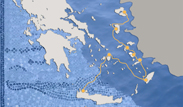The island
Chios is well-favoured in terms of its privileged
geographical location, topography, climate and natural resources, factors which
determined its character from early antiquity.
Neolithic finds from
Emporio and Agios Galas confirm that Chios was
settled early, and seems to have flourished and developed mainly in the years
after the Ionic colonization (11th-10th century BC). When a city-state was
established in the central region of the east coast, in around the 8th
century, it rapidly gained control of the entire island, ushering in a golden
age in shipping, commerce and the arts. Ancient times were to prove turbulent
and unsettled: signs of habitation
have been found from as early as the Neolithic period. In early Christian
times, Saint Isidore was martyred on Chios
during the persecutions of Decius (c. 250). Excavations have revealed that the
island flourished at that time, becoming a major trading hub on the sea route
that linked the new capital at Constantinople
to the eastern provinces of the empire. The emergence of Chios
as a centre of commercial activity was historically linked to the spread of
Christianity in the Aegean – both developments
are illustrated by the remains of early Christian basilicas
basilicas and coastal
settlements and by coin circulation. Among contemporary monuments, the Church of St. Isidore in Chios
town was first built in the mid 5th century as a three-aisled
basilica with a horseshoe-shaped conch
and coastal
settlements and by coin circulation. Among contemporary monuments, the Church of St. Isidore in Chios
town was first built in the mid 5th century as a three-aisled
basilica with a horseshoe-shaped conch .
.
In the mid-Byzantine
period the Aegean was plagued by Arab raids,
leading to stagnation on the islands once more. It was in this climate of
terror that Chios was pillaged by the Arab
caliph Moab
in the mid 7th century. This turbulent time of destruction, abandonment and
unsafe sea routes came to an end in 961, when Nicephorus Phocas recaptured Crete. Emperor Constantine IX Monomachus erected the castle of Chios and founded the monastery of Nea
Moni in the mid 11th century, strengthening ties between the island and Constantinople, as part of imperial efforts to restore
Byzantine rule over areas affected by the Arab peril. Nea Moni is the island’s
most prominent Byzantine monument and one of the most important in all
Byzantine culture; it greatly influenced religious architecture on Chios, as
attested by the churches modelled on it, such as the Virgin Mary Krina in
Vavili, the Church of the Holy Apostles in Pyrgi and the Church of St. George
Sikousis in the village of the same name.
A raid by the Turkish
emir Jahan in 1093, attacks by the Venetians in 1124 and 1171 and brief
subordination to the Latin State of Constantinople loosened Chios’
ties to the Empire and prepared it for the transition to Genoese rule. Under
the Treaty of Nymphaeum (1261), Michael VIII Palaeologus, Emperor of Nicaea,
secured the help of the Genoese in his attempt to recapture Constantinople
from the Franks. In exchange for this he granted them significant trade
privileges and gave them access to many Aegean ports. In Chios’
case, Genoese rule can be divided into two phases. In the first of these
(1307-1329), the Zaccaria brothers assumed control of the island from the
Byzantines after the latter failed to defend it against persistent Turkish
raids. Emperor Andronicus Palaeologus briefly recaptured Chios,
but in 1346 it was given back to the Genoese – this time to the Mahona Company owned
by the Guistiniani family. For the next 220 years the Genoese Giustiniani made successful
and effective use of the island’s produce (gum, wine, silk, citrus fruit) and
its trade and workforce, transforming Chios
into a large and prosperous commercial centre. Part of the Genoese plan for
more systematic and profitable exploitation of the island’s resources involved
establishing the quaint medieval fortified settlements in the south, known as
the Mastichochoria (mastic villages), at Anavatos, Pyrgi, Mesta and Olympi. Chios town and the fertile Kambos plain extending to south
proved favourable not only for citrus tree cultivation, but also for the
monumental architecture of Genoese towers.
The lengthy period of
Ottoman rule began in 1566, when Chios surrendered
almost without a fight to Piali Pasha, and came to an end with the island’s
incorporation into the newly established Greek state in 1912. The Ottomans
granted the islanders tax exemption, allowed the nobility to retain property
and established a local government and trade, providing Chios
with important advantages and enforcing a mild regime, though this failed to
prevent the island from falling into decline. A turning point in Chian society
was reached in the 18th century, with a move towards urbanization that
drastically transformed the prevailing climate and brought the island renewed
growth and prosperity. The expansion of trade to include the major markets of
the West created conditions for the organization of small-scale silk and gum
industries, leading to the growth of the city centre and bringing people in
contact with western education and culture. Via trade and related financial
activities the economy flourished hand in hand with education, as is illustrated
by the establishment of the Chios
School in 1792. Dark
moments in the island’s history include the pillaging and slaughter committed
by the Turks under Ali Kara in 1822, which shocked the European world, and the
devastating earthquake of 1881.
Bibliography (7)▼
Comments (0)▼
New Comment▼











